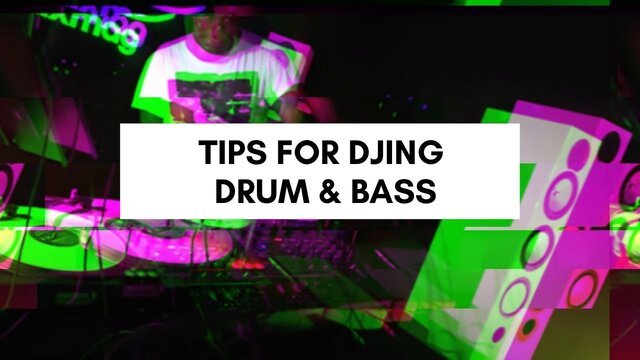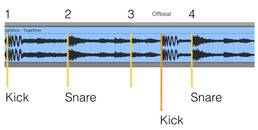
DJing Drum & Bass is one those things in life that feels amazing. The energy, the sub bass, the build ups and the double drops.
Don’t feel left out or feel like you’re struggling, here’s an essential tips list for you DJs out there looking to get better at DJing.
Want to learn Drum & Bass DJing in just 7 days? Click here and elevate your Drum & Bass DJing today.
1. Listen to the Snares when Beatmatching
If you’re struggling with what to listen to when DJing Drum & Bass beats then you’re not alone.
Drum & Bass is fast at 174 BPM, which can sometimes sound like a mess, especially when trying to beat match in your headphones.
The game can change for you though when you start listening to the snares. The common beat structure (not all though) is that the snares hit on the 2nd and the 4th beat of a bar. This is great because it gives you the ability to listen to snares on their own, instead of all the crazy kick drum rhythms that some tracks have.
The snares stand out in the mix too, especially when compared to a kick drum.
When you’re beat matching in your headphones before getting into the mix properly, listen out for the snares hitting and sticking together. Once you’ve got those two beats aligned, jump straight into the mix and transition from one track to another.
2. Know Your Music (Song Structure)
Song structure is fairly obvious in Drum & Bass, especially compared to Dance or House music for example. Even when loading you music into Rekordbox for example, you’ll see straight away there are clearly defined wedges of colour and volumes in the audio wave.
This is a great way to get to know you music inside and out, not only listening to it, but by visually seeing the audio waves of your music collection on DJ software.
Top Tip: After a while, you’ll get to know your music so well that setting memory cue points is less essential because you’ll instinctively know a point in which to start cueing up a new track.
3. Harmonic Mixing
Harmonic mixing is a great way to get your liquid and dancefloor tracks sounding smoother in the mix with one another.
I remember an interview from years ago with a DJs named London Elektricity (who owns Hospital Record btw) has described his own style of DJing as a focus on Harmonic mixing.
There are a lot of chords and vocals involved in the lighter styles of Drum & Bass, and this means that some tracks when mixed together clash when being mixed together. Harmonic mixing can solve this problem and allow tracks that are compatible in key to sound amazing in the mix together.
Here’s a great example of harmonic mixing Drum & Bass I’ve put together.
4. Control the Low End during the Mix
Sub low end frequencies can sound really muddy and grim in the mix, especially on loud speakers it’s way more prominent.
Make sure that your focus is on making sure that both tracks in the mix aren’t doubling up too much bass frequencies in the mix.
You can control this by using the LOW eq filter on your DJ mixer for each channel. The HPF switch can also help you control LOW end frequencies, but use it mainly for fading out at the last 8 to 4 beats as it can be quite a harsh low cut sound.
Want to learn Drum & Bass DJing in just 7 days? Click here and elevate your Drum & Bass DJing today.
5. Download Bootlegs & Remixes (Soundcloud)
Soundcloud is a great way to find FREE music, especially bootlegs are remixes of Drum & Bass. Not only is the music free but a great way to spice up your DJ sets to make them sound unique.
For example, type in the [artist name] + “bootleg” or “remix” and I’d put money on that you’ll find a FREE bootleg download.
Let’s try “tc bootleg” in Soundcloud’s search function.
BOOM!
Third result…
6. Find your USP to stand out from the crowd
DJs that I remember is usually for a specific reason, for example a unique skill that they have, such as scratching, or they are great music producers too.
DJ Marky is one of those DJs that not only produces great music but offers great enthusiasm when DJing for example bopping, dancing and generally giving off great energy. This is a standard that DJ Marky has when DJing. The core of him as a DJ.
Also fairly unique in a way that he still DJs with DVS which is awesome in my view (compared to a lot of other professional Drum & Bass DJs use CDJs / all-in-one DJ Controller).
The icing on the cake is that DJ Marky can scratch like a demon, and usually has a unique style, such as scratching to the melody of a Jump Up Drum & Bass track.
The cherry on top is when he picks up the turntable, turns it upside down and starts scratching. WTF!!!
Stand out from the crowd, be known for something special and different, it will help you get noticed.
7. Understand Beat Structures (Patterns)
The beauty of Drum & Bass music is that there’s so much drum pattern variation.
There’s not just one “standard” type of beat pattern that D&B follows. Sure there’s a common type of beat in D&B as seen below, but there are plenty of variations.

Understanding these amazing patterns is helpful for DJs trying to beat match Drum & Bass & beats where they aren’t the exact same beat structures.
Beat matching is an art that requires some practice, but knowledge of different beats can really help you build an ear for the specifics, such as the snares, of what to listen out for when beat matching.
See the ‘Drum Beat Patterns‘ section in the article here.
8. DJ all Styles of Drum & Bass
Being open minded to mix and blend all styles of Drum & Bass will make you a great DJ and a great selector of music.
You’ll also find that you’ll get to know and remember different song structures, which is great to know where to cue up and blend in tracks too.
Having a greater range of Drum & Bass can sometimes give you more freedom to transition and evolve the energy and vibe in your DJ mixes also.
9. Find Free Drum & Bass Beats to Mix
Finding free Drum & Bass is another great way to change up your DJ mixes from other DJs out there playing the chart topping D&B. Check out a great article from LoveThatBass below for some free downloads.
10. Practice, Practice, Practice
Consistent practice is going to hone your DJ skills and knowledge of your music collection, which in turn will make if easier when you’re plucking tracks in an un-planned DJ set.
Ultimately there will come a point in which DJing will be second nature, making it all that more fun to mix and blend music. Below are some great ways to practice and put yourself under pressure to develop as a Drum & Bass DJ.
Practice Plan Examples:
1. Mix fast, un-planned DJ mix, selecting any track from your collection. No pre-set cue point, no reference points to start mixing in from, just go guns blazing. Mix as fast as you can. You’ll get to know your quickly and really well doing this, plus its a bit of fun too.
2. Live stream. Setup a live stream, start streaming for a couple of hours. Mixcloud is a great way to start mixing on a live stream, no takedowns. This practice technique gets you closer to DJing live in a club for example. Putting pressure on you really helps get you comfortable DJing in any situation.
3. Set up a party. Get a party setup with your friends, setup your DJ Equipment and practice being a great selector. It will allow you to practice reading the crowd and which tracks to play one after another. Of course another way to do this is DJ at a bar or club which a step up on another level.
4. Record yourself. Audio and video. Then post it on your social media (if you feel comfortable). Knowing that you are recording live will add pressure for you to perform to a high standard.
5. Practice a specific technique for 30 minutes non-stop. Double drop or quick drop switches of basslines for example. Focussing on one technique for a prolonged amount of time will only engrain an ability to perform that ability.

